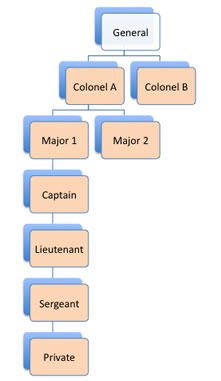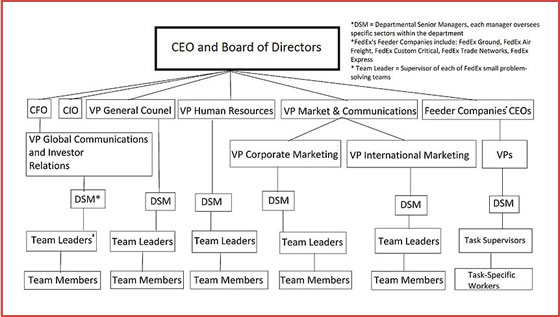Very Formal Communication

Today we’re going to discuss formal communication, which is, of course, communication of any means where the sender and receiver are both wearing formal dress – tuxedo for men, gown for women. Whoa whoa, hang on, team. Don’t copy and paste that, its’ just a joke. Just kidding! Formal communication, seriously defined, is the communication that takes place along the “official” lines of communication within an organization. In the military, we used to refer to these “official” lines as the “chain of command.” You don’t hear that phrase very often in the civilian world. “Line of Authority” or “Organizational Management Structure” is what it’s more commonly called when not wearing a military uniform, but the idea is the same. At the top is the CEO, the president or the commander. At the bottom are the newest, lowest-level employees or the soldiers. In between are the supervisors, the middle-level managers, the officers, vice-presidents, etc. Except for the boss of the organization, everyone has someone else to report to: their immediate supervisor. These supervisors manage their workers, and in turn, report to those individuals who supervise them. In an ideal structure, every worker will have only one supervisor.
Formal communication channels move along these lines of communication in specified directions and can take just about any form. Information moves downward from higher levels to lower levels. It can move upward from workers to and through their supervisors. It can also run horizontally, in between employees of the same level. Formal messages can be written or oral, but will take on a professional tone, utilizing accepted standards for communicating within the specific organization or those of standard business practices. Oftentimes, these accepted standards are just that – accepted. There is no official “rulebook” that governs formal communications.

Formal communication is mission-focused, relating specifically to the current project or task at hand. Written messages – emails, memos, formal business letters that need to go outside the company – will be task-oriented in their tone and will supply or request information only directly related to the mission. Oral communication in a formal setting will happen in presentations and meetings. These groups can be as small as two people or as large as a filled auditorium (with tele-conferencing or internet capabilities, presentations can even take place on a global scales with thousands of participants). These environments will also carry a mission-focused attitude. This is not to say that everything must be “mister this” and “miss that” and “Sir” and “Madam” and such. An element of familiarity, such as using a colleague’s first name doesn’t necessarily belie the formality of a situation. This also doesn’t mean that everyone is completely serious at all times and everyone is expected to be talking like robots, but there is a level of seriousness to be expected and there are unspoken and unwritten rules about acceptable behavior. A worker’s behavior is typically only noticed when the aforementioned rules are bent or broken. Calling the CEO of the company by her first name when not given permission, or taking your shoes off and putting them up on the conference table would be seen as unacceptable within the formal channels of communication.
Informal Communication
Informal communication will, of course, take on a more relaxed, casual feel. It works within the social structure of the organization and falls outside the lines of authority. Where formal communication is guided by expectations and protocols through all stages of a message, informal communication is easy and often spontaneous. It can happen anywhere and anytime, and can take on a myriad of forms. Even a non-verbal smile or a pat on the back could be considered informal communication. [These could also be formal communication messages as well, depending upon the context.] Be careful about that pat, though, lest it be construed as sexual harassment and you end up in a bit of hot water.
Formal and Information Communication – When Should I Use Which?
From our definitions and descriptions of each, it should be fairly obvious when we should be using formal communication as opposed to informal. Remember, when we define formal communication, we are referring to any type of job-focused message that takes place within the organization’s management structure. The fact that this structure exists is one of the advantages of formal communication. Within this structure, everyone knows their role and what’s expected of them: professionalism at every level.
There are some gray areas where formal and informal channels of communication cross, one of them being social media. Sites such as Facebook are certainly informal environments; however, higher-ranking individuals in an organization will sometimes access the accounts of their employees. There have been numerous accounts in the news where employees have lost their jobs because of social media postings. Apparently Facebook is not to be considered an informal communication medium. Also, we mentioned the “unwritten rules” of the formal communication environment. We cover some of these in the Communication in the Workplace article. Make sure you check them out. Make sure you’re using your common sense too!
As always, thanks for reading! We’d love to hear your comments, questions or formal communication-related stories. MC
—-
Get Paid to Write
Turn the writing skills you already have into a highly-paid recession-proof profession …working part time! You’re already a writer. Find out how you can earn $100 to $150 per hour from this little-known lucrative profession.












Please comment with your real name using good manners.